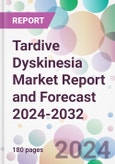Tardive Dyskinesia Market Outlook
The tardive dyskinesia market size is anticipated to grow at a CAGR of 3.2 % during the forecast period of 2024-2032, driven by growing awareness about the importance of monitoring patients on long-term antipsychotic therapy for early signs of tardive dyskinesia in the major markets.Tardive Dyskinesia: Introduction
Tardive dyskinesia is a neurological disorder characterized by involuntary, repetitive body movements. It primarily affects the face, causing grimacing, blinking, or lip-smacking, but can also involve limbs or the torso. Tardive dyskinesia commonly arises as a side effect of long-term use of certain antipsychotic medications, particularly older ones. The condition can be distressing and socially isolating. Treatment focuses on medication adjustments, and in some cases, specific medications may be used to alleviate symptoms.Key Trends in the Tardive Dyskinesia Market
There's growing awareness about the importance of monitoring patients on long-term antipsychotic therapy for early signs of tardive dyskinesia. This trend is leading to the adoption of regular, systematic assessments to ensure early intervention and prevent progression.Pharmaceutical research is increasingly focused on developing new and more effective treatments for tardive dyskinesia. These include drugs targeting specific neurotransmitter systems involved in the condition, offering potential improvements over existing therapies.
There's a trend in psychiatric care to preferentially use newer, atypical antipsychotic medications, which have a lower risk of causing tardive dyskinesia compared to older, typical antipsychotics.
The market is seeing a shift towards more personalized treatment plans, taking into account individual patient needs, medication history, and lifestyle factors. This trend is in line with a broader move in healthcare towards personalized medicine.
Regulatory agencies are increasingly recognizing the impact of tardive dyskinesia and are fast-tracking the approval of promising treatments. This trend is facilitating quicker access to effective medications for patients.
There's a growing emphasis on educating healthcare providers and patients about tardive dyskinesia, its risks, and the available treatment options. This trend is improving diagnosis rates and encouraging more proactive management of the condition.
Tardive Dyskinesia Market Segmentation
Market Breakup by Type
- Bradykinesias
- Hyperkinesias
Market Breakup by Drug Class
- Dopamine-Depleting Medications
- VMAT2 inhibitors
- GABA Receptor agonist medications
- Anticholinergic Medications
Market Breakup by End User
- Hospital
- Clinics
Market Breakup by Region
- United States
- EU-4 and the United Kingdom
- Germany
- France
- Italy
- Spain
- United Kingdom
- Japan
Tardive Dyskinesia Market Overview
In North America, the tardive dyskinesia market is influenced by a high prevalence of mental health disorders and the extensive use of antipsychotic medications. The region shows a proactive approach in addressing the condition, with a significant focus on medication management, patient education, and awareness. Advances in treatment options, including the approval of new drugs specifically targeting tardive dyskinesia symptoms, are driving market dynamics. There's also a growing emphasis on monitoring and early detection to prevent or mitigate the condition.Europe's market benefits from strong healthcare infrastructure and a comprehensive approach to mental health treatment, including the management of medication side effects like tardive dyskinesia. The region has stringent regulatory standards for drug approval and a focus on research and development, contributing to the availability of advanced treatment options. Awareness campaigns and patient advocacy groups play a crucial role in promoting understanding of the condition and supporting affected individuals.
Japan's market for tardive dyskinesia is characterized by a high standard of healthcare and a strong emphasis on precision medicine. The country is proactive in addressing the side effects of psychiatric treatments, with a focus on balancing medication efficacy and patient quality of life. Advances in medical research and a regulatory environment that supports rapid adoption of innovative treatments contribute to the market's growth. Efforts are also directed towards patient education and the integration of monitoring systems to manage and prevent the condition effectively.
Tardive Dyskinesia Market: Competitor Landscape
The key features of the market report include patent analysis, grants analysis, clinical trials analysis, funding and investment analysis, partnerships, and collaborations analysis by the leading key players.- Teva Pharmaceutical Industries
- Medicure Inc
- Mylan N.V
- Bionpharma
- Hetero
- Johnson & Johnson Services, Inc.
- Bausch Health
- Sanofi
- GlaxoSmithKline Plc.
- Lupin Pharmaceuticals Inc
- Amgen Inc
- Novartis AG
- Lilly
- Lannett Co Inc
- Neurocrine Biosciences, Inc
This product will be delivered within 5-7 business days.
Table of Contents
Companies Mentioned
- Teva Pharmaceutical Industries
- Medicure Inc
- Mylan N.V
- Bionpharma
- Hetero
- Johnson & Johnson Services Inc.
- Bausch Health
- Sanofi
- GlaxoSmithKline Plc.
- Lupin Pharmaceuticals Inc
- Amgen Inc
- Novartis AG
- Lilly
- Lannett Co Inc
- Neurocrine Biosciences Inc








